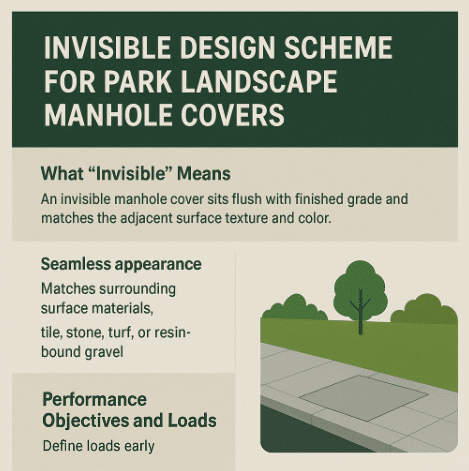Parks demand infrastructure that protects utility access yet preserves visual harmony. An invisible design scheme lets manhole covers blend with paving, turf, or resin-bound gravel while meeting load, safety, and maintenance goals. This guide explains the performance criteria, material options, and installation details that deliver a discreet, durable result.
What “Invisible” Means in Park Contexts
An invisible manhole cover sits flush with finished grade and matches the adjacent surface texture and color. Crews still gain full access, but visitors rarely notice the access point.
Key attributes:
- Seamless appearance: tile, stone, turf, or resin infill matches surroundings.
- Flushness: <3 mm step between cover and adjacent surface in pedestrian zones.
- Quiet operation: rattle-free seating and acoustic pads.
- Safe traction: verified slip resistance in wet conditions.
Performance Objectives and Loads
Parks face varied service conditions. Define loads early:
- Pedestrian and bicycles (A15–B125): promenades, plazas, boardwalks.
- Service carts and small maintenance vehicles (C250): internal paths, plazas with occasional vans.
- Perimeter roads or shared access (D400): where waste or emergency vehicles may pass.
Beyond static load, require:
- Impact resistance from wheels at low speed.
- Fatigue durability under repeated passes.
- Deflection control to maintain flushness and prevent trip hazards.
Cover Typologies for Invisible Schemes
Choose the structure that fits the landscape layer:
- Paver-Infill Frames
- Steel or ductile-iron tray receives concrete bedding, then the same unit pavers as the field.
- Ideal for plazas and decorative pavements.
- Specify corner keys and torsion-free stiffeners to limit flex.
- Stone or Tile Infill Trays
- For natural stone, porcelain, or terrazzo.
- Use decoupling membranes and flexible grout to absorb thermal movement.
- Require edge protection profiles to prevent spalling.
- Resin-Bound Aggregate Infill
- Quick install, permeable options available.
- Good color match; UV-stable binders maintain appearance.
- Turf/Grass Infill Lids
- Perforated trays with engineered soil and root barrier.
- Integrate sub-drainage and irrigation sleeves to keep turf healthy.
Materials and Corrosion Strategy
- Ductile Iron: high strength, excellent fatigue behavior, long life.
- Stainless Steel (304/316): premium finish for coastal or high-corrosion sites.
- High-grade Aluminum: lightweight lids where frequent access is required; check deflection.
- Composites (FRP/SMC): non-corrosive, low magnetic signature, stable color; ensure verified load rating.
Protective details:
- Powder-coat or epoxy systems for steel.
- Anodizing for aluminum.
- Replaceable seating gaskets to prevent metal-to-metal wear.
Safety and Accessibility
Design for safe movement in all weather:
- Slip resistance: Specify wet pendulum or equivalent test values suitable for public walkways.
- Flush installation: set to surrounding grade; verify after compaction and final sanding.
- Clear opening and ergonomics: hinge options keep lids controlled; gas struts reduce lift force.
- Locking mechanisms: tamper-resistant bolts or concealed latch systems deter theft and vandalism.
- Acoustic control: elastomer pads and precise tolerances eliminate rattle.
Drainage, Waterproofing, and Soil Interface
Invisible covers must keep surfaces dry and subgrades stable:
- Perimeter drip channels and weep holes move water to bedding layers.
- Butyl or EPDM seals resist ponding where waterproofing is required.
- For turf lids: use free-draining soil mix, geotextile separation, and sub-drains tied to the park’s LID network.
- Thermal movement joints at stone or tile infill prevent cracking.
Installation Best Practices
- Survey and Elevation Control
- Set frames from a finished-grade benchmark.
- Use laser levels; allow for final surface thickness.
- Bed and Seat the Frame
- Support with non-shrink grout or polymer-modified mortar.
- Achieve full-contact bearing to avoid rocking.
- Backfill and Compaction
- Compact in lifts to the required density; avoid bridging under the frame.
- Protect seating surfaces from debris during works.
- Infill Construction
- Match pattern, joint width, and color to adjacent field.
- For pavers, cut courses inside the tray; bond to setting bed as specified.
- Commissioning
- Check flushness, slip resistance, and lid operation.
- Document torque values for locks and finalize O&M notes.
Maintenance and Life-Cycle Planning
- Quarterly inspections for flushness, gasket wear, and lock integrity.
- Surface care follows the host material: seal stone as per plaza schedule; mow and irrigate turf lids.
- Record access frequency to plan gasket and hinge replacements.
- Clean drainage channels to prevent silting and freeze-thaw damage.
A well-planned maintenance program extends service life and preserves the invisible aesthetic.
Specification Checklist (Copy-Ready)
- Load class: ___ (A15 / B125 / C250 / D400)
- Clear opening: ___ × ___ mm; frame depth: ___ mm
- Material: ductile iron / stainless 316 / composite
- Surface infill: paver / stone / resin-bound / turf
- Slip resistance: minimum wet value ___ (method ___)
- Flushness tolerance: ≤3 mm, any direction
- Locking: tamper-resistant with concealed hinge preferred
- Seal: continuous EPDM gasket, replaceable
- Drainage: perimeter channel + weep holes / waterproofed lid
- Finish: powder-coat RAL ___ / anodized ___ / factory sealed
- O&M: gasket part no. ___; recommended torque ___ Nm
Common Pitfalls to Avoid
- Over-long spans that flex and crack infill.
- Insufficient bearing under frames, leading to rocking.
- Ignoring thermal movement in stone or tile.
- No drainage path, which traps water and stains surfaces.
- Mismatched textures that reveal the cover location.
Conclusion
An invisible design scheme for park landscape manhole covers demands clear performance targets, fit-for-purpose materials, and disciplined installation. When teams align architectural intent with engineering rigor, the result is safe, quiet, durable, and visually seamless access that enhances the park experience rather than interrupting it.
FAQs
Q1: Which load class should I select for park paths?
Choose A15 or B125 for pedestrian zones. Select C250 where small maintenance vehicles operate. Use D400 along shared service roads.
Q2: Do invisible covers compromise access speed?
No. Hinged, gas-assisted lids and tamper-resistant locks enable fast, safe access while keeping the surface discreet.
Q3: What surface finish gives the best slip resistance?
Textured pavers or resin-bound aggregates provide reliable wet grip. Specify a tested wet slip value in the contract.
Q4: How do I keep paver infill from rattling?
Provide full-contact seating, elastomer gaskets, and corner anti-lift keys. Verify flushness during commissioning.
Q5: Can I use turf-infill lids in shaded areas?
Yes, but use shade-tolerant species, engineered soil, and drip irrigation. Confirm adequate drainage below the tray.
If you’d like, I can tailor a schema.org FAQPage snippet for your CMS, or turn this spec checklist into a printable PDF.





